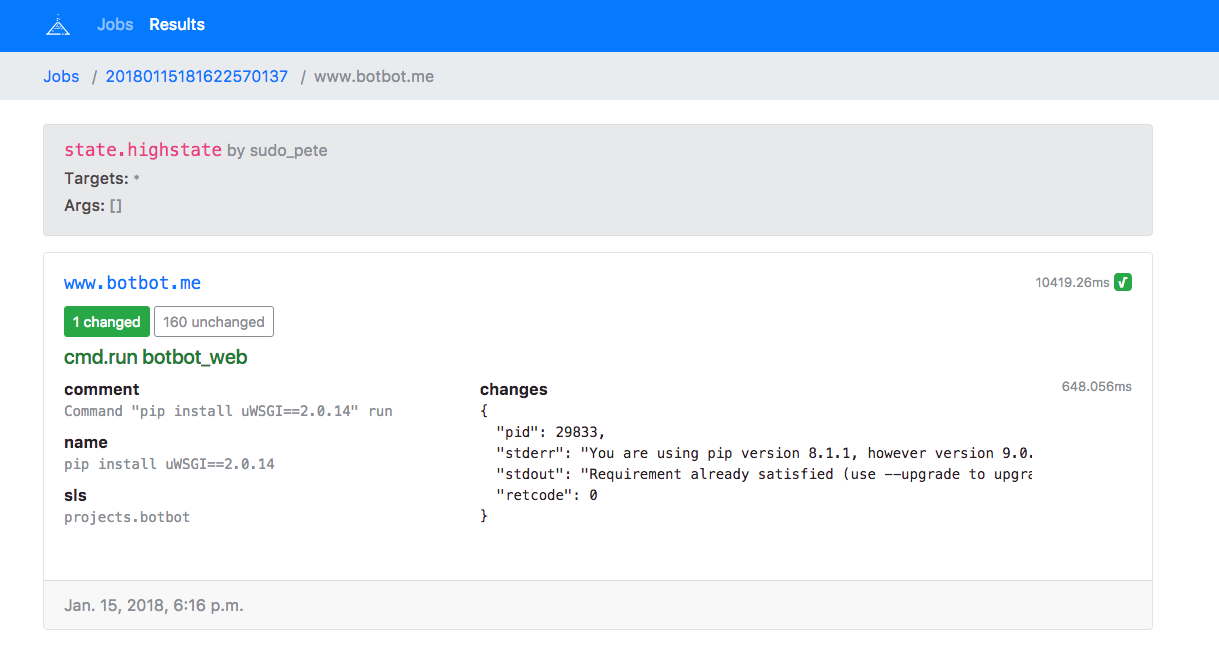A Dahsboard for SaltStack's Job Cache
Project description

# Salt Dash
Read-only web interface to read from Salt’s [external job cache](https://docs.saltstack.com/en/latest/topics/jobs/external_cache.html) using the [pgjsonb](https://docs.saltstack.com/en/latest/ref/returners/all/salt.returners.pgjsonb.html) returner.

## Running Locally
Install [Yarn](https://yarnpkg.com/lang/en/docs/install/) for building the front-end.
Install [Pipenv](https://docs.pipenv.org/) for the back-end.
`bash make all pipenv shell saltdash migrate saltdash runserver `
## Client-side Development
Currently using [parcel](https://parceljs.org/). To start a development environment with live reloading, run:
`bash cd client yarn run watch `
## Running in Production
saltdash runserver is not suitable for production. A production-level webserver is included and can be started with saltdash serve. If Docker is more your speed, there’s a Dockerfile as well.
### Configuration
Configuration can be done via environment variables, a file, or a combination of both thanks to [Goodconf](https://pypi.org/project/goodconf/). By default it will look for a YAML file named saltdash.yml in /etc/saltdash/ or the current directory. You can also specify a configuration file with the -C or –config flags. saltdash-generate-config can be used to generate a sample config file containing the following variables:
DEBUG Enable debugging. type: bool
SECRET_KEY _REQUIRED_ a long random string you keep secret https://docs.djangoproject.com/en/2.0/ref/settings/#secret-key type: str
DATABASE_URL type: str default: postgres://localhost:5432/salt
ALLOWED_HOSTS Hosts allowed to serve the site https://docs.djangoproject.com/en/2.0/ref/settings/#allowed-hosts type: list default: [‘*’]
GITHUB_TEAM_ID type: str
GITHUB_CLIENT_ID type: str
GITHUB_CLIENT_SECRET type: str
SENTRY_DSN type: str
LISTEN Socket for webserver to listen on. type: str default: 127.0.0.1:8077
GitHub Team authentication is included by setting the relevant GITHUB_* variables.
You’ll need to setup an OAuth App at https://github.com/organizations/<org>/settings/applications with a callback URL in the form: https://your-site.example.com/auth/complete/github-team/
To retrieve your team IDs:
Create [a token at GitHub](https://github.com/settings/tokens)
curl -H “Authorization: token <token>” https://api.github.com/orgs/<org>/teams
## Setting up Salt
Once you’ve setup a Postgresql database using saltdash migrate, connect Salt’s external job cache to the database by adding the following lines to /etc/salt/master.d/job_cache.conf:
`ini # Replace items in brackets with actual values master_job_cache: pgjsonb returner.pgjsonb.host: [db-host] returner.pgjsonb.pass: [db-password] returner.pgjsonb.db: [db-database-name] returner.pgjsonb.port: [db-port] returner.pgjsonb.user: [db-user] `
Restart your salt-master and all future jobs should get stored in the database.
If you have lots of jobs, you’ll probably want to purge the cache periodically. A helper command is provided to do just that, run:
`bash saltdash purge_job_cache [days_older_than_to_purge] `
If you want to automate this, use the –no-input flag to bypass the confirmation prompt.
## Attributions
Icon by [BornSymbols](https://thenounproject.com/term/salt/705369) used under CCBY license.
# Changelog for saltdash
0.9 (2018-05-14)
Initial PyPI release
Project details
Release history Release notifications | RSS feed
Download files
Download the file for your platform. If you're not sure which to choose, learn more about installing packages.












